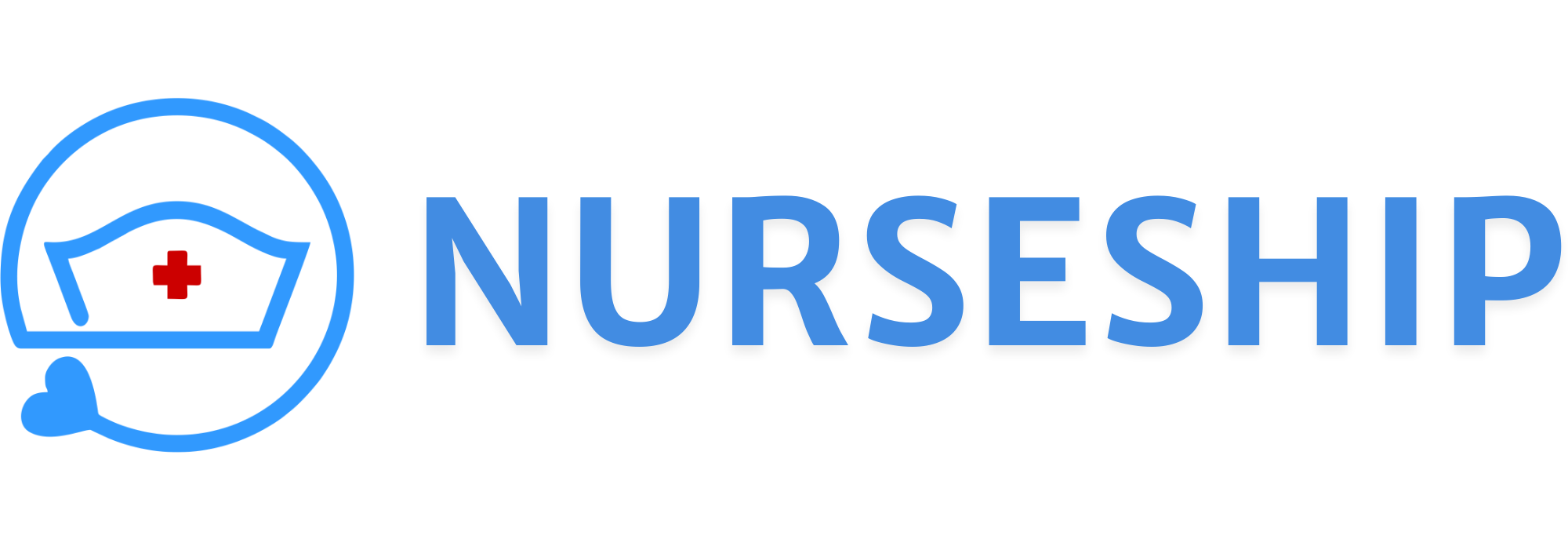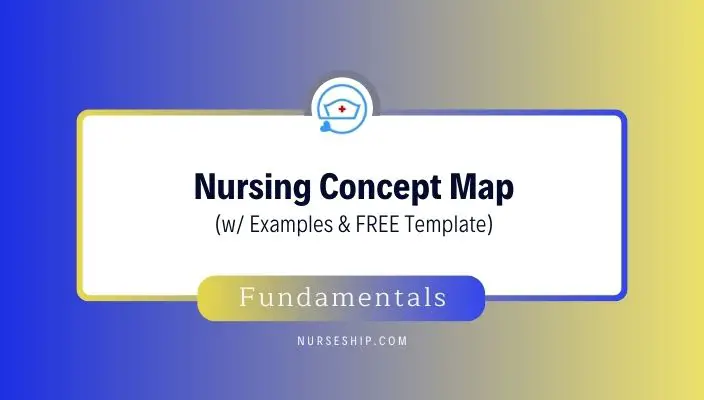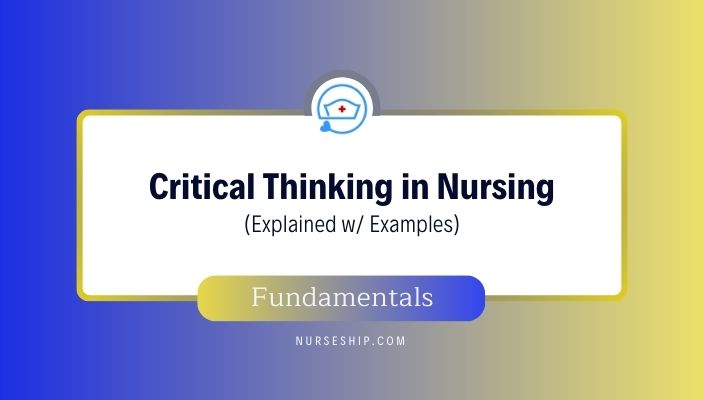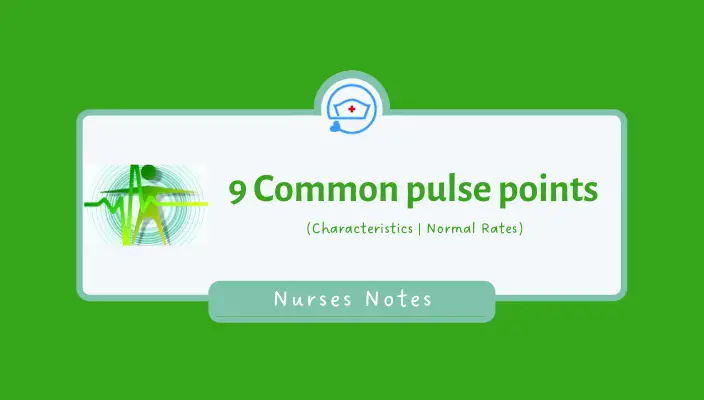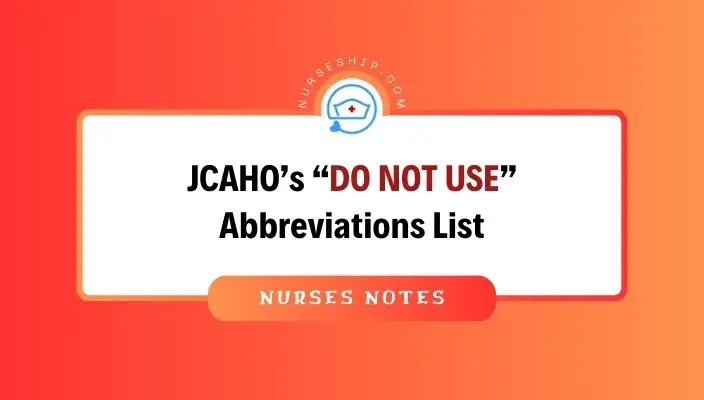Nursing concept maps are dynamic tools with significant value for nurses and especially nursing students starting their educational journey.
In this article, we will learn about concept mapping in nursing and how to apply it to nursing.
Also, we will give a FREE PDF Concept Map Template.
You may also want to check out 15 Attitudes of Critical Thinking in Nursing (Explained W/ Examples)
What is Concept Map?
A concept map also known as a mind map is a visual tool that represents relationships and connections between different concepts or ideas.
It is a graphical representation of information that helps to organize and understand complex topics or subjects.
Concept maps are often used to illustrate how different concepts relate to one another, showing hierarchies, connections, and dependencies.
In a concept map, concepts are represented as nodes or boxes, and the relationships between concepts are depicted using lines or arrows.
The lines connecting the nodes indicate the nature of the relationship, such as “is a part of,” “causes,” “leads to,” “is related to,” and more.
These maps can vary in complexity, from simple diagrams with a few nodes to intricate structures with numerous interconnected concepts.
Concept maps are widely used in education, brainstorming, research, and problem-solving.
They provide a visual representation that helps individuals grasp the bigger picture, understand the connections between ideas, and identify key concepts within a complex system.
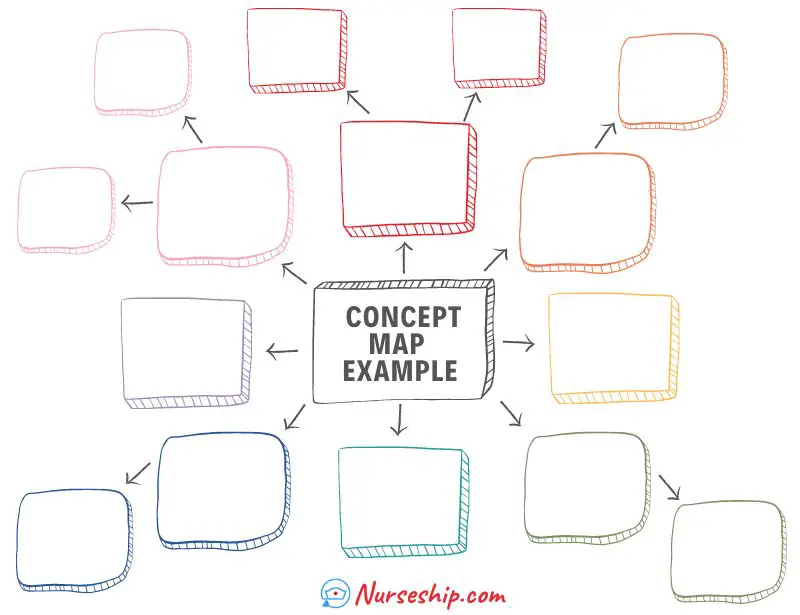
Definition of Concept Map
A concept map can be defined as a visual representation that depicts the relationships and connections between various concepts or ideas in a structured and organized manner.
What is a Nursing Concept Map?
In the context of nursing, a concept map is a visual representation that illustrates the relationships between various nursing concepts and their connections within a particular patient’s care or a broader nursing context.
Concept mapping in nursing is a valuable tool for critical thinking, clinical reasoning, and effective communication among healthcare professionals.
Nursing concept maps are used to:
- Organize Information: Nursing concepts such as patient assessment, nursing diagnoses, interventions, and patient outcomes can be organized and displayed visually to help nurses and other healthcare providers better understand the care plan.
- Facilitate Care Planning: Concept maps allow nurses to create a structured plan of care for their patients. This includes identifying nursing diagnoses, selecting appropriate interventions, and predicting potential outcomes.
- Enhance Critical Thinking: Creating a concept map encourages nurses to think critically about the relationships between different aspects of patient care. It helps them identify potential issues, connections, and factors that might impact patient well-being.
- Promote Collaboration: Concept maps can be shared among healthcare professionals, fostering better communication and collaboration among nurses, doctors, therapists, and other team members involved in patient care.
- Improve Patient Education: Concept maps can be simplified and shared with patients to help them understand their medical conditions, treatment plans, and the role of nursing interventions in their care.
- Assist in Decision-Making: Nurses can use concept maps to evaluate different approaches to patient care, considering the potential outcomes of each intervention and selecting the best course of action.
- Document Patient Progress: Over time, nurses can update concept maps to reflect changes in the patient’s condition, modifications to the care plan, and progress toward desired outcomes.
A nursing concept map typically includes components such as nursing diagnoses, patient assessment data, interventions, expected outcomes, and evaluation criteria.
It visually presents the connections between these components, allowing nurses to make informed decisions and provide effective care.
It’s important to note that creating effective concept maps in nursing requires a solid understanding of nursing concepts, patient care processes, and critical thinking skills.
Concept mapping is a dynamic process that evolves as the patient’s condition changes and as the care plan is adjusted based on ongoing assessment and evaluation.
Why Use a Concept Map in Nursing?
Concept mapping is useful in nursing because it can visually represent nonlinear and linear relationships, which aids in the development of critical thinking, analytical skills, and clinical reasoning.
By linking attributes of concepts, concept maps help nurses make meaning of complex ideas, enabling them to visualize information in their own way.
Concept maps offer a way to focus on key concepts and relationships, making them quicker than note-taking and a beneficial tool for care planning, organizing nursing care, and understanding complex concepts.
They bridge existing nursing knowledge with new information and enhance critical thinking. Concept mapping also helps connect theoretical knowledge to clinical practice.
This approach enables nurses to plan care for patients and families effectively while addressing multiple complex problems, ultimately improving clinical reasoning.
What are the Types of Concept Maps?
Concept maps come in various types, each tailored to specific purposes and contexts. Some common types of concept maps include:
Hierarchical Concept Maps:
These show a main concept at the top, with related sub-concepts branching out beneath it, emphasizing relationships and hierarchy.
Spider Concept Maps:
Radiating from a central concept, these maps explore related ideas, making them useful for brainstorming and idea generation.
Flowchart Concept Maps:
Illustrating processes and workflows, they depict sequential steps and decisions in a clear, linear manner.
Systematic Concept Maps:
These demonstrate the components and interactions of a complex system, useful for understanding system dynamics.
Comparative Concept Maps:
Used for analysis, they highlight similarities and differences between concepts, objects, or ideas.
Storyline Concept Maps:
Showing relationships in a narrative format, they’re used for plotting stories, historical events, or case studies.
Venn Diagram Concept Maps:
They display overlapping relationships among sets of concepts, helping to identify commonalities and distinctions.
Mind Maps:
Although not concept maps per se, mind maps start with a central idea and branch out with associated thoughts, fostering creativity and idea exploration.
Network Concept Maps:
Emphasizing connections without hierarchy, they reveal complex relationships and dependencies.
Tree Concept Maps:
Organizing concepts in a hierarchical tree structure, they’re suitable for classification and categorization.
Cross-Linking Concept Maps:
Linking concepts based on shared attributes, they offer a multidimensional view of relationships.
These diverse types of concept maps cater to different learning styles, communication needs, and information structures, allowing users to select the most suitable format for their specific purposes.
How Do You Create a Nursing Care Plan Concept Map?
Creating a nursing care plan concept map involves visually representing the relationships between various nursing concepts, patient assessment data, nursing diagnoses, interventions, and expected outcomes.
Here’s a step-by-step guide to creating a nursing care plan concept map:
Step 1: Choose a Patient Scenario:
Select a specific patient scenario or case for which you want to create a nursing care plan concept map.
This could be a patient with a specific medical condition or a set of nursing diagnoses.
Step 2: Gather Patient Data:
Collect relevant patient data, including medical history, physical assessment findings, lab results, and any other information that informs the nursing care plan.
Step 3: Identify Nursing Diagnoses:
Based on the patient data, identify relevant nursing diagnoses. These are clinical judgments about actual or potential health problems that nurses are licensed to treat.
Each nursing diagnosis represents a specific problem or need that requires nursing interventions.
Step 4: Organize Diagnoses Hierarchically:
Place the identified nursing diagnoses at the center of your concept map. Branch out from each diagnosis with lines to represent related concepts such as assessment data, interventions, and expected outcomes.
Step 5: Add Assessment Data:
Connect assessment data relevant to each nursing diagnosis. This could include physical assessment findings, patient history, and any other data that contributes to the identification of the diagnosis.
Step 6: Include Interventions:
Add nursing interventions associated with each nursing diagnosis.
These interventions should be evidence-based and targeted toward addressing the specific patient needs and diagnoses.
Step 7: Predict Expected Outcomes:
Predict the desired outcomes that result from implementing the nursing interventions.
These outcomes should reflect the improvement, stabilization, or prevention of the patient’s health problem.
Step 8: Define Relationships:
Draw lines or arrows to show the relationships between nursing diagnoses, assessment data, interventions, and outcomes.
Use labels to describe the nature of these relationships, such as “supports,” “leads to,” or “addresses.”
Step 9: Evaluate and Refine:
Review your nursing care plan concept map to ensure that the relationships make sense, interventions are appropriate, and outcomes are achievable. Make revisions as needed.
Step 10: Share and Implement:
Share the nursing care plan concept map with other healthcare professionals involved in the patient’s care.
Use it as a guide to communicate the planned interventions and outcomes, and update it as the patient’s condition changes.
Creating a nursing care plan concept map helps you visualize the comprehensive care plan for your patient, ensuring that you consider all relevant aspects of their condition and tailor your interventions accordingly.
Nursing Concept Map Examples
Sample of Nursing Care Plan Concept Map
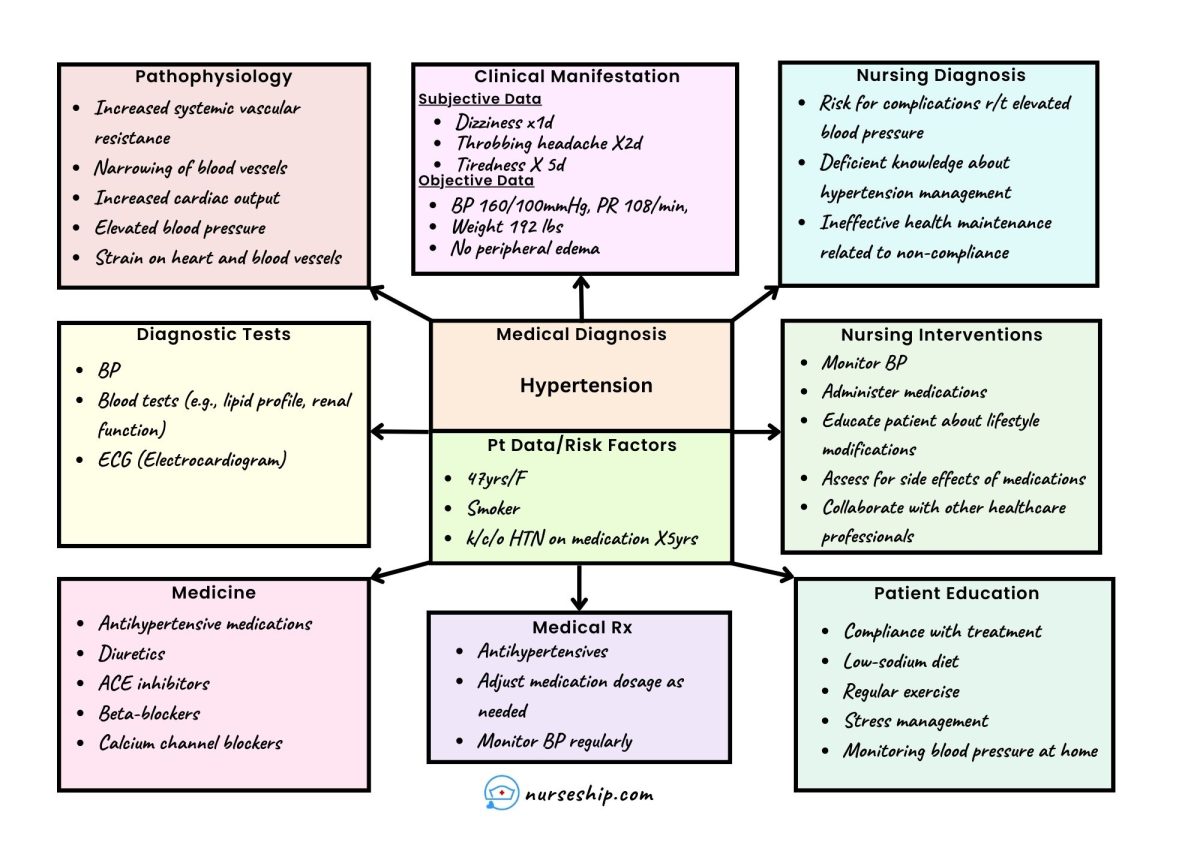
Sample Hypertension Nursing Concept Map
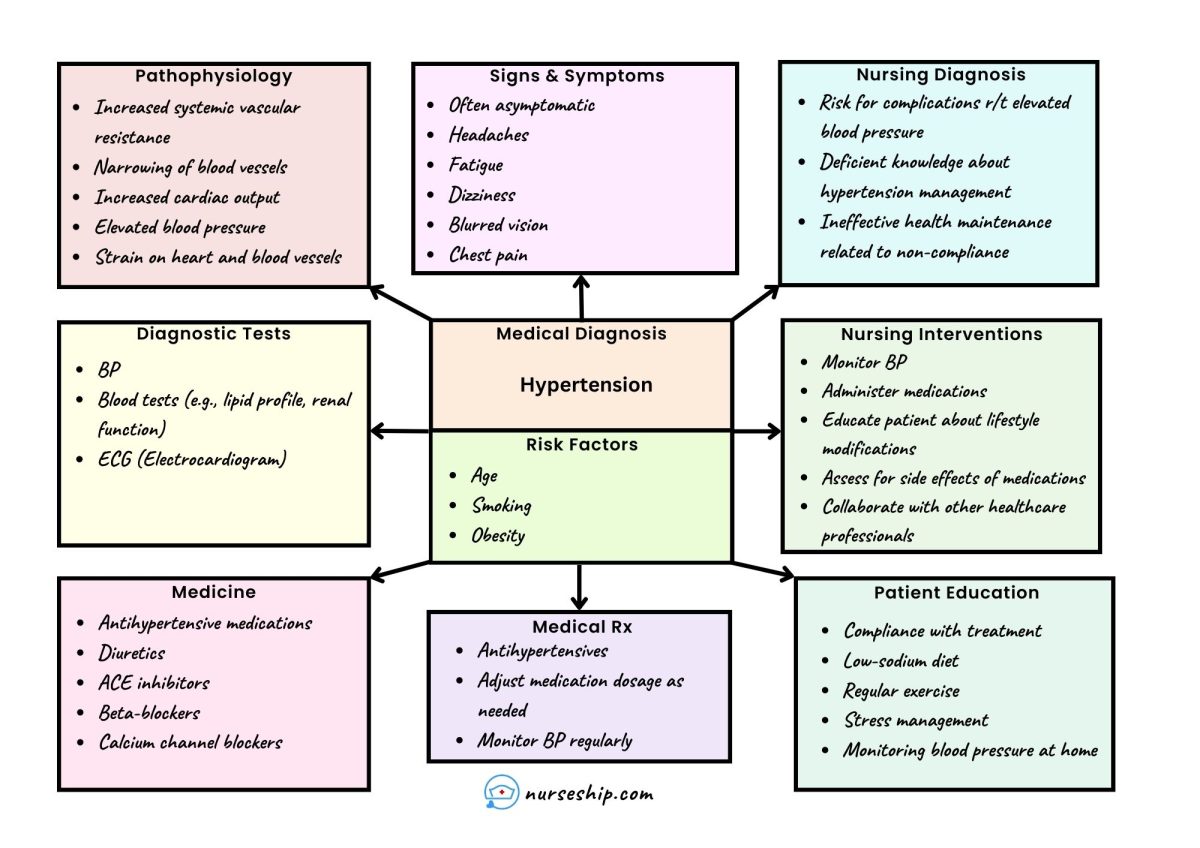
Download FREE Nursing Concept Map Template
See Also
- How To Improve Critical Thinking Skills In Nursing? 24 Strategies With Examples
- Clinical Reasoning In Nursing (Explained W/ Example)
- 8 Stages Of The Clinical Reasoning Cycle
- What Are Socratic Questions?
- What is the “5 Whys” Technique?
Conclusion
In conclusion, nursing concept maps offer nursing students an invaluable means to comprehend intricate healthcare concepts, promoting the development of critical thinking and clinical reasoning skills.
By visually representing relationships and care plans, these maps aid students in translating theoretical knowledge into practical patient care scenarios, fostering a holistic approach to nursing education.
